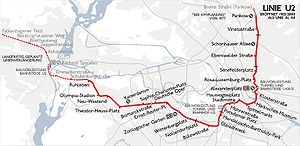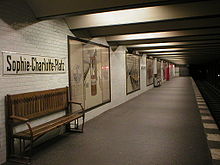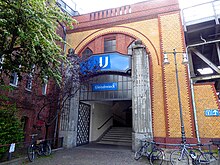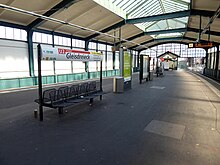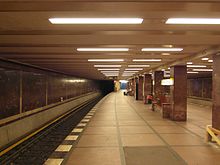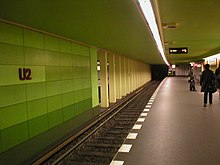Subway line 2 (Berlin)
| Line Berlin U-Bahn small profile |
|||||||||||||||||||||||||||||||||||||||||||||||||||||||||||||||||||||||||||||||||||||||||||||||||||||||||||||||||||||||||||||||||||||||||||||||||||||||||||||||||||||||||||||||||||||||||||||||||||||||||
|---|---|---|---|---|---|---|---|---|---|---|---|---|---|---|---|---|---|---|---|---|---|---|---|---|---|---|---|---|---|---|---|---|---|---|---|---|---|---|---|---|---|---|---|---|---|---|---|---|---|---|---|---|---|---|---|---|---|---|---|---|---|---|---|---|---|---|---|---|---|---|---|---|---|---|---|---|---|---|---|---|---|---|---|---|---|---|---|---|---|---|---|---|---|---|---|---|---|---|---|---|---|---|---|---|---|---|---|---|---|---|---|---|---|---|---|---|---|---|---|---|---|---|---|---|---|---|---|---|---|---|---|---|---|---|---|---|---|---|---|---|---|---|---|---|---|---|---|---|---|---|---|---|---|---|---|---|---|---|---|---|---|---|---|---|---|---|---|---|---|---|---|---|---|---|---|---|---|---|---|---|---|---|---|---|---|---|---|---|---|---|---|---|---|---|---|---|---|---|---|---|---|
| Route length: | 20.7 km | ||||||||||||||||||||||||||||||||||||||||||||||||||||||||||||||||||||||||||||||||||||||||||||||||||||||||||||||||||||||||||||||||||||||||||||||||||||||||||||||||||||||||||||||||||||||||||||||||||||||||
| Gauge : | 1435 mm ( standard gauge ) | ||||||||||||||||||||||||||||||||||||||||||||||||||||||||||||||||||||||||||||||||||||||||||||||||||||||||||||||||||||||||||||||||||||||||||||||||||||||||||||||||||||||||||||||||||||||||||||||||||||||||
| Power system : | side busbar painted above 750 V = |
||||||||||||||||||||||||||||||||||||||||||||||||||||||||||||||||||||||||||||||||||||||||||||||||||||||||||||||||||||||||||||||||||||||||||||||||||||||||||||||||||||||||||||||||||||||||||||||||||||||||
|
|||||||||||||||||||||||||||||||||||||||||||||||||||||||||||||||||||||||||||||||||||||||||||||||||||||||||||||||||||||||||||||||||||||||||||||||||||||||||||||||||||||||||||||||||||||||||||||||||||||||||
The U2 line of the Berlin subway has 29 stations and is 20.7 kilometers long. It begins in the northeastern district of Pankow , leads through the eastern center with Alexanderplatz , through the old city center via Potsdamer Platz to the western center ( Wittenbergplatz , Zoo station ) and via the Olympic Stadium to the final stop in Ruhleben . Like the U1 , U3 and U4 lines , it belongs to the sub-network of the Berlin subway that was opened before 1914 and is known as the “ small-profile network” because of the narrower vehicles and tunnels .
Line color and labels

Since the introduction of the schematic line network plans on the Berlin subway, at least parts of today's U2 line have always been red. When letters were introduced as line designations after the First World War , the small-profile network was given the letters "A" and "B". The inner city route, more important than the older route through Kreuzberg , became line A, as did the two western branches to Charlottenburg and Dahlem (today's lines U2 and U3). The routes from Kurfürstendamm and Schöneberg through Kreuzberg to Warschauer Brücke (today: U1 and U4) were given the letter “B” and the color code green. To distinguish between the branches in the western branch, the letters were Roman numerals supplemented the Charlottenburg line was thus the line A I .
From 1966, the names of the lines used by the Berlin public transport company (BVG-West / BVG) in West Berlin were changed to Arabic numbers . Each line should be operated independently and without branches. The ("green") line 1 now drove from Ruhleben through Charlottenburg to Kreuzberg, the previous A II became the ("red") line 2 ( Krumme Lanke - Gleisdreieck , from 1972 only to Wittenbergplatz ). The separated eastern part of the line, used by BVG-Ost / BVB since 1949, retained the "A" as the line designation, as did the red color code.
On 9 January 1984, the SNB also assumed to date by the Deutsche Reichsbahn managed tram -lines in West Berlin. The labeling of the underground lines used by the BVG changed again because the underground and S-Bahn lines now operate in parallel. In order to better differentiate the two tractions , the Arabic number, which has been valid since 1966, has been preceded by the letter "U" as a line number. According to the model of local transport networks , such as B. in Munich , they were then called U1 to U9 and equivalent to the taken over S-Bahn routes with a prefixed "S" and the route number.
With the growing together of Berlin as part of German reunification and the reconstruction of the disused section Wittenbergplatz - Mohrenstrasse (1993), the BVG decided to swap the western branches of the U1 and U2 lines that meet at Wittenbergplatz. The reunited former line A I has been running under the new name "U2" since then, but as before through the two previously separated parts of the city with the traditional red line identification color.
course


The subway begins in the west of Berlin at Ruhleben station and runs over a dam between Rominter Allee and the Hamburg light rail connection until it disappears into a tunnel just before the curve to Olympische Straße and continues to follow the street mentioned. Then the U2 swings onto Reichsstraße to Theodor-Heuss-Platz , where it curves to Kaiserdamm . Under the Kaiserdamm, which later becomes Bismarckstrasse , the subway runs straight ahead to Ernst-Reuter-Platz . Here in turn it swings to the southeast on the course of Hardenbergstrasse in the direction of the Zoologischer Garten station . In the tunnel, it goes around the foundations of the Kaiser Wilhelm Memorial Church in a narrow arc and then follows Tauentzienstrasse , where the route to Wittenbergplatz - east of the Kleiststrasse / Courbierestrasse junction - merges over a ramp into the elevated railway section.
The elevated railway reaches its full height at the Nollendorfplatz underground station . There are four more underground tracks underground. On Nollendorfplatz all four lines of the low-profile network meeting. The elevated railway follows the Bülowstraße in an easterly direction . Then the U2 makes a curve over a long viaduct over the southernmost point of the route in the Park am Gleisdreieck to the Gleisdreieck underground station and then runs straight over the Landwehr Canal and merges into a tunnel again between the Mendelssohn-Bartholdy-Park and Potsdamer Platz stations .
In the further course, this does not lead through Leipziger Straße , as requested by the former elevated railway company , but rather curvy through Mohrenstraße , Markgrafenstraße and Niederwallstraße to the Spreeufer at Spittelmarkt . After passing the Märkisches Museum station , the U2 crosses under the Spree in a long tunnel and leads through Klosterstrasse to Alexanderplatz station .
Behind this the route makes a swivel to Rosa-Luxemburg-Straße . This is followed by Schönhauser Allee , which runs relatively straight in a northerly direction . One street south of the Eberswalder Strasse station , the tunnel section will be converted into a viaduct, followed by two elevated stations on Schönhauser Allee . The continuation of Schönhauser Allee beyond the former city limits is Berliner Straße , where the elevated railway line turns into a tunnel again and reaches the terminus in Pankow .
This makes the U2 the only subway line in Berlin from which all other lines of the subway (except the U55 , which will be added to the U5 ) as well as the main S-Bahn lines (north-south Bahn, Stadtbahn , Ringbahn ) can be changed.
history
The main line of the subway
The increasing traffic problems in the metropolis of Berlin led to the search for new, efficient means of transport at the end of the 19th century.
In particular, the entrepreneur Werner von Siemens tried to get permission to build a new type of rapid transit system. Siemens and other interested parties made numerous suggestions, although both the proposed route (there was great economic interest in the posh Friedrichstrasse and the important Leipziger Strasse shopping street) and the technical systems turned out to be quite different. So there were ideas for a suspension railway , as it was later built in Wuppertal , a low-lying tubular railway like in London or an elevated railway based on the American model.
The construction of elevated railways through the narrow Friedrichstrasse and Leipziger Strasse was not permitted. Finally, after many years and negotiations, Siemens prevailed with an elevated railway line from the Warschauer Brücke via Hallesches Tor and Bülowstrasse . The resistance to the new type of transport in Berlin appeared to be surmountable with this route, and it also promised to expand the tram into an inner ring. The private company Siemens & Halske also carried out all construction work as the client. The first groundbreaking was on September 10, 1896 in Gitschiner Strasse. The construction work had to go quickly, because the contract concluded with Berlin when the license was awarded stipulated that the route had to be completed within two years, otherwise there would be a penalty of 50,000 marks (adjusted for purchasing power in today's currency: around 361,000 euros).

After tough negotiations with the city of Charlottenburg , it was decided not to build an elevated railway on Tauentzienstrasse , but to build a sub-paved railway and run the route to "Knie" (today's Ernst-Reuter-Platz ). So the requirement to complete the line by January 1, 1900 could not be met. The recently replaced top management of the Berlin City Planning Office viewed the subject of the underground with significantly greater benevolence. Since the subway obviously did not cause any damage to the then new sewer system, an underground branch to Potsdamer Platz was to be created. A further extension to what was then Berlin's city center was now possible at any time. The state approval for the planning changes went to the elevated railway company in an addendum on November 1, 1900 .
The entire project of the elevated and underground railway now had a length of 10.1 kilometers. The largest part of the route, around eight kilometers, was to be built on viaducts and connect eleven elevated stations. There were also two kilometers of tunnels with three underground stations. The planners at the time believed that no 8-car trains were needed and had the platforms built with a length of 80 meters. This was just enough for a 6-car train.
In the first year after the turn of the century, a six-kilometer route was completed. After around five and a half years of construction, the main line was ready. On February 15, 1902, the so-called “ministerial trip” took place on the route Potsdamer Platz - Zoological Garden - Stralauer Tor - Potsdamer Platz. This was so called because many Berlin personalities took part in the opening trip, including the Prussian Minister of Public Works , Karl von Thielen . On February 18, 1902, the first section of the Berlin subway was officially opened ( Stralauer Tor - Potsdamer Platz). The so-called "western trunk line" to the zoological garden was opened in March and was extended to the knee on December 14th . On August 17, the route to Stralauer Tor was extended by 380 meters to the Warsaw Bridge. Back then there were only two lines:
- Warschauer Brücke - Potsdamer Platz junction - Zoological Garden
- Warsaw Bridge - directly without a branch - Zoological Garden
Today the majority of the trunk line belongs to the U1 (Warschauer Straße - Möckernbrücke), the section Gleisdreieck - Zoologischer Garten is currently used by the U2.
The Charlottenburg subway
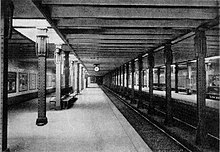
After the opening of the main route, further plans were made to extend the three branches of the route, to the knee , Potsdamer Platz and the Warschauer Brücke. The negotiations with the up-and-coming city of Charlottenburg were the quickest , as there was a lot of undeveloped land there that could be developed. The most important point of negotiation was the construction of a route to the Charlottenburg town hall on Wilhelmplatz (since 1934: Richard-Wagner-Platz ). An extension along Berliner Strasse (today: Otto-Suhr-Allee ) would have been an option, but the Berlin-Charlottenburg tram was running there at that time and parallel traffic did not seem sensible. Therefore, this route should continue under Bismarckstrasse to the west and then in an arc to the town hall. Under the working title Krumme Strasse , the Bismarckstrasse (today: Deutsche Oper ) stations and then the Wilhelmplatz terminus were planned. The line between Knie and Wilhelmplatz was opened on May 14, 1906. Both underground lines now went to Bismarckstrasse , but only the trains that went to the junction to Potsdamer Platz also went to Wilhelmplatz underground station .
While this line was still under construction, the elevated railway company and the city of Charlottenburg agreed on a junction towards Westend . Therefore, the planned Bismarckstrasse station was changed in planning, because the line to Westend was to branch off here. Therefore, the first four-track underground station in Germany was built here, the inner tracks of which led to Wilhelmplatz , the outer ones to Westend.
Since the western Charlottenburg area was still completely undeveloped, the Westend line was not yet able to generate any profits in its early years. Therefore, the elevated railway company negotiated with the city of Charlottenburg and the other landowners to compensate for the line deficit. This contract was signed on June 23, 1906. The following stations were to be built for the route to the west:
- Bismarckstrasse (today: Deutsche Oper),
- Sophie-Charlotte-Platz ,
- Kaiserdamm ,
- Reichskanzlerplatz (today: Theodor-Heuss-Platz, provisional end point).
On March 16, 1908, Emperor Wilhelm II drove this route for the first time, based on the “Ministerfahrt”. It was officially inaugurated on March 29, 1908. The two existing lines did not continue to Reichskanzlerplatz , but a third line was opened that only ran between Bismarckstrasse and Reichskanzlerplatz .

Due to the significantly increased length of the route, a new workshop was also required, because the previous workshop in Rudolfstrasse (or Warschauer Brücke) was no longer sufficient. That's why they looked for a suitable site. Since the Prussian forest administration wanted to market part of the Grunewald profitably, the interests of both partners met. The Hochbahngesellschaft bought 14 hectares of land to build the Grunewald workshop there. At the same time, it committed itself to building a route extension for the new construction of the former German Stadium (today: location of the Olympic Stadium ). For this, the elevated railway company received a grant from the forest administration of 200,000 marks (adjusted for purchasing power in today's currency: around 1,166,000 euros). But for the time being, only operational and occasional traffic should take place here, regular traffic was not yet planned. At the same time as the extension, the shell of the Neu-Westend station was also built on the route , because there was no need for traffic at the time.
On June 8, 1913, together with the new stadium, the route to the Stadion underground station (today: Olympic Stadium ) and the Neu-Westend station, which is still under construction , was opened. The Grunewald workshop was completed in January 1913.
The "center line"
After the so-called "trunk line" had been extended to what was then Wilhelmplatz (today: Richard-Wagner-Platz) in Charlottenburg, the elevated railway company also planned to connect the city center of Berlin to the new subway. However, the city of Berlin first prohibited this because, given the success of the first line, it made its own plans for the construction of subways. But the highest decision-maker, the Berlin police chief , stepped in and approved the plans.

The elevated railway company planned to run the new line in a straight line under Leipziger Strasse from Potsdamer Platz to Spittelmarkt . The "Great Berlin Tram", whose route ran through this street, together with the city of Berlin, prevented the realization of these plans by threatening to claim damages.

The negotiating partners finally agreed on the long-term route via Spittelmarkt , Alexanderplatz and Schönhauser Allee to Nordring station. The plans initially envisaged the Kaiserhof (today: Mohrenstraße ), Friedrichstraße (today: Stadtmitte ), Hausvogteiplatz and Spittelmarkt stations . Later the line was to continue through the following stations: Inselbrücke (today: Märkisches Museum ), Klosterstraße , Alexanderplatz , Schönhauser Tor (today: Rosa-Luxemburg-Platz ), Senefelderplatz , Danziger Straße (today: Eberswalder Straße as a high station) and Nordring (today : Schönhauser Allee as a high station).
Since the section on the Spittelmarkt was to be very complex and cost-intensive due to the necessary underpassing of the Spree , the plans included a (cheaper) elevated railway line in Schönhauser Allee as compensation . Construction work began on December 15, 1905. In order to enable continuation, the Potsdamer Platz station , which was then provided with side platforms , was demolished. On September 28, 1907, the new Leipziger Platz station (today: Potsdamer Platz) was opened 200 meters away .
A train station of the same name was built behind the Spittelmarkt in 1908. This is directly on the Spree, so that the ground is very boggy . A pile foundation was necessary to prevent the station from sagging . A window gallery was built towards the Spree. This was closed in World War II and only reopened in 2004.
The “Spittelmarktlinie” was officially opened on October 1, 1908. There were now four different lines, two of which used the new line:
- Warschauer Brücke - Potsdamer Platz - Spittelmarkt, and
- Wilhelmplatz (Charlottenburg) - Wittenbergplatz - Potsdamer Platz - Spittelmarkt.
The Schönhauser Allee gets an elevated railway
In March 1910, construction work began to extend the “Spittelmarktlinie” (now also called “Centrumslinie”) to the north. There were some challenges here too. Behind the Spittelmarkt train station, the route runs along the banks of the Spree . Therefore, a slope had to be built to cross under the river bed. The Inselbrücke station (today: Märkisches Museum) was built there at a depth of around six and a half meters . Since the station was so low, a curved station, which is rare in Berlin, could be built. An impressively high barrel vault covers the platform; It is the only column-free underground station in Berlin next to Platz der Luftbrücke .
Behind this station, the line crossed under the Spree and turned onto Klosterstrasse with the station of the same name. Since there were plans at that time to build a branch line under Frankfurter Allee , space was left in the middle of the platform for another track. Today a similar route leads from Alexanderplatz to Frankfurter Allee. From Klosterstrasse we went to Alexanderplatz. When building this station, care was taken to ensure that stairs to other lines could be added later. The opening of the “Centrumslinie” between Spittelmarkt and Alexanderplatz took place on July 1, 1913. The line between Alexanderplatz and Wilhelmplatz quickly became the most popular line.
In the further course this route led to Schönhauser Allee. There, with the Schönhauser Tor station (today: Rosa-Luxemburg-Platz ), the first station under today's Torstrasse was built . Since the Schönhauser Allee was wide enough, there were no problems with the tunnel construction.
This was followed by the Senefelderplatz station. Behind this a ramp rises out of the tunnel and leads to what was then the Danziger Straße station (today: Eberswalder Straße). As mentioned, this was designed as an elevated railway, because the tunnel at Spittelmarkt was very cost-intensive and the construction of the elevated railway on the wide Schönhauser Allee was very inexpensive.
Behind the Danziger Straße station there was a longer elevated viaduct to the then Nordring station (today: Schönhauser Allee). There the already existing ring line was crossed, but not underground, but on an even higher level. Today's S-Bahn runs there in the cut. This was the end point of the route at that time. The extension from Alexanderplatz to the Nordring was opened just three and a half weeks after the opening of the route to Alexanderplatz on July 27, 1913.
The new track triangle
One of the most dangerous parts of the entire underground network was the Gleisdreieck , which connected the main line between the Warschauer Brücke and the Zoological Garden with the branch line to Potsdamer Platz. This junction was secured by signals alone, so that an inattentive driver could trigger a disaster. Such a disaster happened on September 26th, 1908. An elevated train hit another train in the flank and pushed two cars off the platform. One of the cars fell off the viaduct. 21 passengers were killed. A reconstruction of the track triangle was then ordered.
Construction work began in May 1912. Instead of a triangular track, a cross-shaped layout with a new crossing station was planned. There is only a connecting track between the two lines for internal purposes. The renovation was basically carried out during full operation, with various lines being temporarily shut down. Gleisdreieck station was opened on November 3, 1912, but construction work lasted until August 1913.
Two new terminus
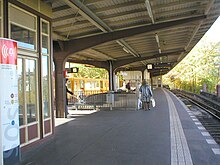
In the years of the Weimar Republic , the small profile network was only slightly expanded. Since May 22, 1922, there has been regular train service to the stadium and the Neu-Westend station, which had already been erected in the shell, was finally ready for use.
The new Gleisdreieck train station was also completed to form a complete cross; the "relief line" from Gleisdreieck via Kurfürstenstraße to Nollendorfplatz was opened on October 24, 1926. The sparingly designed underground station Kurfürstenstraße bears witness to the difficult financial situation of the time. In connection with the construction of the relief line, the Nollendorfplatz subway station was also to be completely rebuilt and redesigned, as the subway of the formerly independent city of Schöneberg (today's U4 line) was still operated independently, although it had been owned by the City of Berlin belonged.
The main line from the Nordring to the stadium at that time was to be extended by one station in both directions. The Pankow train station was built in the north in 1930 (today: Vinetastraße). There was one main reason for its construction: The trains at Nordring station ran so often that it was not possible to turn the train on the viaduct. It was much easier to sweep the trains underground. A further planned extension to the Breiten Straße in Pankow or to the Pankow S-Bahn station was no longer possible; construction was not continued until 1997. At the opposite end, the line was extended by one station to the new Ruhleben terminus on December 22, 1929 . The route ran on a dam; the continuation through garden and industrial grounds to nearby Spandau was to begin a little later. However, the Great Depression and World War II never made these plans a reality, the extension from 1929 to this day is the last stop at the western end of the U2.
National Socialism and World War II
After the “ seizure of power ” by the National Socialists , two train stations on line A I were named after “heroes” of the Nazi movement. The Reichskanzlerplatz station (today: Theodor-Heuss-Platz) became Adolf-Hitler-Platz on April 24, 1933 . The Schönhauser Tor station (today: Rosa-Luxemburg-Platz) was named on May 1, 1934 after the SA storm leader Horst Wessel .
After the plans to transform Berlin into the “ World Capital Germania ” in 1939, however, relatively little should change in the route of the then line A compared to the other plans of that time. In addition to the northern extension to the Pankow train station , which has been planned for years and referred to as Pankow (Breite Straße) in the plans , the elevated railway line at Gleisdreieck was to be dismantled and replaced by a new, underground, straight line to the Bülowstraße subway station . The proposals for an extension to Spandau that appeared in previous and later plans were not incorporated. The lines F I and F III planned at the time were to be used for this. The first tunnel work even began at today's Theodor-Heuss-Platz , but was stopped again in 1941. After the prophesied “ final victory ” these should be resumed.
After the attack on Poland on September 1, 1939, the instructions were to only allow all means of transport to run with darkened headlights. This not only affected the vehicles, but also the stations of the S-Bahn and U-Bahn - only sparse lights were on here.
From autumn 1943, the air raids on Berlin increased sharply - according to regulations, the underground stations had to remain closed in the event of an air raid. However, this was seldom the case: large crowds often streamed into the stations in the mistaken belief that they were protected from the attacks there. For example, the exit of the Senefelderplatz train station was buried by a bomb on the night of November 3rd to 4th, 1943. In 1944 there were many air raids and the BVG was only able to maintain operations with great difficulty. The railway stations Gleisdreieck, Nollendorfplatz , Bülowstraße , Reichssportfeld (today: Olympiastadion), Potsdamer Platz and Klosterstraße were particularly affected .
In 1945 the situation worsened and in some cases the underground trains only ran as shuttle trains between a few stations. Finally, on April 25, 1945, operations came to a complete standstill.
Shortly before the end of the Battle of Berlin , SS troops blew up the north-south S-Bahn tunnel at the Landwehr Canal on May 2, 1945 , which, in addition to flooding the S-Bahn tunnel, also led to the water entering through the connecting passages Subway system flowed. Line A I was completely under water between the Alexanderplatz and Potsdamer Platz stations and it took a long time to repair the damage.
New start after the end of the war
After the surrender , repairs to the subway network began. On May 14, 1945 the first trains were running again (in the area around Hermannplatz ). On May 17th, the first shuttle trains between Knie and Kaiserdamm as well as Kaiserdamm and Ruhleben were able to run on the section of line A I. The Reichskanzlerplatz and Schönhauser Tor stations, which were renamed at the time of National Socialism , got their original names back. In the following months, further sections were able to go into operation, on September 18, the trains on the A I sections Pankow - Potsdamer Platz and Gleisdreieck - Ruhleben were already in circulation, between the Potsdamer Platz and Gleisdreieck stations there was still a shuttle service.
The split of the city and June 17, 1953
The beginning of the Cold War and its first major escalation , the Berlin blockade in 1948/1949, caused great uncertainty among Berliners. Many West Berliners avoided East Berlin . So new traffic flows were formed that bypassed the eastern sector. The Berliner Verkehrsbetriebe, the operator of the subway, split in 1949 into an East and a West company. While bus and tram lines now ended at the sector boundary, the subway remained with continuous traffic.
On August 18, 1950, the sixth anniversary of Ernst Thälmann's death , the Kaiserhof underground station was reopened under the name Thälmannplatz . The A I line was thus continuously operational again. The subway station at Wilhelmplatz in the heart of the government district was previously called after the Hotel Kaiserhof , because the name Wilhelmplatz had already been given to the subway station built a few years earlier in Charlottenburg on the square of the same name (today: Richard-Wagner-Platz). Thälmann's wife and daughter, Rosa and Irma Thälmann , took part in the opening ceremony and the renaming of the square . Since the government of the GDR mainly resided in the old government district of Wilhelmstrasse, they wanted a representative train station. It is unique in Berlin because of its design with Saalburg marble in the style of the 1950s. The East Berlin press described him as the most beautiful in Berlin.
At the beginning of 1953 the West-BVG set up loudspeakers at the last train stations in the western sectors to warn of the crossing of the Soviet sector. Sweeping systems were set up at these stations so that the trains could end there. In addition, she designed the timetable so that at the same time a subway went east and another train returned. Thus, in the event of an incident, the west would lose few vehicles to the east.
This proved itself in June of the same year, when East Berlin workers responded with protests at the increase in the labor standard . Information about the June 17 uprising spread like wildfire throughout the GDR. About 20,000 strikers demonstrated not only against the norm increases, but also against the general conditions in the country. The BVG East and the German Reichsbahn presented the operation of the subway or the opposite about 11:00 train one. The west trains now ended in the prepared sweeping systems. In total, the West Berlin BVG only lost 18 trains due to the well thought-out timetable. On the northern section of line D with the stations Voltastraße and Gesundbrunnen , which had no connection to the rest of the western network, operations were discontinued.
A few days after the bloody suppression of the uprising, the traffic situation returned to normal. As a consequence of the experiences of June 17th, the West-BVG set up a new route of the A II from Krumme Lanke to Kottbusser Tor , independent of the eastern sector , which was soon abandoned. In addition, the Schöneberg subway now only ran to Nollendorfplatz , not as before to Warschauer Brücke .
The construction of the wall
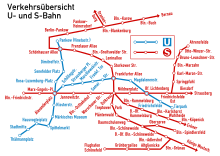
The construction of the Berlin Wall to seal off the sector border between the two parts of Berlin also divided Line A, which crossed the whole city from east to west. By order of the GDR Interior Minister Karl Maron , the trains on Line A in East Berlin now ended at Thälmannplatz station .
Lines C and D (today: U6 and U8) were left to the West-BVG, but their stations in the eastern sector were closed. At the Stadtmitte and Alexanderplatz stations, it was no longer possible to change from line A (east) to lines C and D.
However, BVG-West did not end its trains at Potsdamer Platz, as Maron assumed, but rather one station earlier, at Gleisdreieck. Turning tracks had already been installed there as a precaution at the beginning of the 1950s. BVG-Ost used Potsdamer Platz station as a turning facility and occasionally even parked trains under West Berlin territory.
With this decision, the last common means of transport of the Berliners was separated, because the tram and the omnibus had not crossed the sector border since 1953. The S-Bahn ran under the direction of the GDR-controlled Deutsche Reichsbahn and could therefore not count as a common means of transport.
The consequence of August 13, 1961 was that the East Berlin S-Bahn was increasingly boycotted in West Berlin . It was not uncommon for the slogans to be chanted: “The S-Bahn driver pays the barbed wire” or “Not a penny more for Ulbricht ”. West Berliners traveled by subway, bus and - if still available - by tram .
Line A in East Berlin
Due to the division of the subway network, only two lines remained under the direction of the Ost-BVG: the entire line E from Alexanderplatz to Friedrichsfelde , which was opened in 1930 and connects the center with the working-class districts in the eastern parts of the city, and the eastern one Part of Line A between Pankow and Thälmannplatz , in principle the route through the city center and Schönhauser Allee opened between 1908 and 1913 . Both lines cross in the center of East Berlin, the Alexanderplatz, where there is also a connection to the S-Bahn. The other two lines in the Mitte district were - as described in the previous chapter - left to the West-BVG, the stations in the eastern sector were closed and their entrances bricked up; they became ghost stations .
The subway was less important in East Berlin than in West Berlin, where the focus was more on the extensive S-Bahn and tram networks. In 58 years (1930–1987) only one new underground station was built in the eastern part of the city, while numerous new S-Bahn and tram routes were built.
Temporary current plans to use line C (U6) in East Berlin itself and to extend line A in the area of the Stadtmitte station in its tunnel along Friedrichstrasse were not implemented.
The stations Stadtmitte , Hausvogteiplatz , Spittelmarkt , Rosa-Luxemburg-Platz and Senefelderplatz were redesigned in the 1960s and received new wall tiles. The Märkisches Museum and Klosterstrasse train stations were extensively rebuilt for the 750th anniversary of Berlin in 1987, and instead of the advertising space that was not needed in the socialist economic system, they received artistic depictions of urban development and historical buses and trains. The Alexanderplatz station was hardly changed and remained almost in its original state, as was the station at Potsdamer Platz, which had been unused for 32 years.
The new station at Bismarckstrasse
Due to the S-Bahn boycott and the shutdown of the tram, the subway in West Berlin was massively expanded. However, this only affected the more modern large-profile network (today's lines U6 to U9 as well as preliminary construction work at the Turmstrasse and Jungfernheide underground stations for an U5 extended from East Berlin towards Tegel Airport ). The construction work in the small-profile network was limited to the construction of new transfer stations to new underground lines.
In the area of today's U2, this happened in 1978 in Charlottenburg, between the existing stations Deutsche Oper and Sophie-Charlotte-Platz .
In the course of the construction of line 7, a tangential line that connects several district centers outside of the actual city center, several existing lines were crossed. These included lines 4, 2 (today: U3), and 1 (today: U2). The intersection with the latter was created in the Bismarckstrasse / Wilmersdorfer Strasse area , 380 meters west of the Deutsche Oper station. Despite the short distance to this station, a new crossing station was built to create the necessary transfer options.
At the beginning of construction work, the branch line from the Deutsche Oper to Richard-Wagner-Platz, last referred to as line 5, was shut down on May 2, 1970. After its completion, this connection was taken over by the new line 7.
Since the already 70-year-old tunnel on Line 1 consisted only of weakly reinforced concrete and at that time there was no experience with this construction method, the BVG simply had the entire construction demolished and rebuilt it from a completely closed reinforced concrete frame. After that, an underground station could be built in a convenient location, and an underground tower station was created. Line 7 received a 110 meter long and 11.6 meter wide platform. For the small profile line, however, two uncomfortable side platforms, each four and a half meters wide, were built. For the construction of a central platform , the tracks would have had to be pulled apart and the line had to be taken out of service for a long time. The new station went into operation under the name 'Bismarckstraße' together with the extension of line 7 on April 28, 1978. Until 1961, the Deutsche Oper underground station, located 380 meters to the east, bore this name.
Interim uses of the elevated railway line
Flea market, Turkish bazaar and museum tram
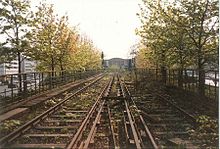

The line in the border area to East Berlin between Gleisdreieck and Potsdamer Platz has been idle since the Wall was built on August 13, 1961. The section between Wittenbergplatz via Nollendorfplatz and Bülowstraße to Gleisdreieck was hardly used anymore because it was no longer possible to continue to what was then East Berlin . For economic reasons, operations on the section used by Line 2 at that time were also discontinued on January 1, 1972; the trains on line 2 from the direction of Krumme Lanke now ended at Wittenbergplatz.
The unused elevated railway line through the north of Schöneberg now offered space for many facilities and experiments for temporary use . The route tunnel from Wittenbergplatz in the direction of Nollendorfplatz served as a turning system since there was no other way of changing the direction of travel for line 2.
In the high station of the station Nollendorfplatz on after the popular name Nollendorfplatz taught 1,973 Nolle called flea market in 16 decommissioned subway cars one. On the tracks themselves there was a new restaurant owned by the then tenant Heini Holl, which was called "Zur Nolle".
A shop resembling the Nollendorfplatz station was built in Bülowstrasse station - the Berlin fair began there in 1975 . Since this project could not prevail, it was ended a year later. A new business idea started on May 28, 1978. The U-Tropia - Station of Nations project was set up in two subway cars that were no longer needed . The wagons were fitted with toilets, and many things were sold in the station itself.
To increase the attractiveness of the two markets, the BVG set up a shuttle service with museum trams on an elevated railway in August 1978. But U-Tropia did not last long, it closed again in the winter of the same year. As long as no new project was set up in the Bülowstrasse high station, the tram also had to pause. In September 1980 the Turkish Bazaar project was located in the Bülowstrasse high station. This market was successful and lasted until the elevated railway was put back into operation. The tram service on the elevated railway track was stopped on February 28, 1991.
Test track for automatic train operation
After the installation of the linear train control on the U9 line, the SelTrac operations control system from SEL was tested without passengers on a part of the unused elevated railway section from 1977 to 1981 . This enabled driving with an absolute braking distance and thus a compression of the train sequence. For this purpose , the tracks between the Bülowstrasse and Potsdamer Platz subway stations , exclusively both due to other uses (markets and parking facilities), were equipped with line conductors. Two small-profile double railcars received SelTrac vehicle devices. A system was installed with operations management, dispatch center, operations center up to point control and station equipment. The line conductor loops were used to transmit the driving license and other information as well as location. For this purpose, the line cable loops, a maximum of 3.2 kilometers in length, crossed every 25 meters.
The M-Bahn
In the Gleisdreieck station , only the upper platform - that of Line 1 - was in operation, whereas there were no longer any passenger trains on the lower platform. On December 2, 1980, at the request of the Berlin Senate , the Berlin House of Representatives decided to provide AEG with the section of line that had been used in automatic SelTrac test operations since 1977 for test operation with a magnetic levitation train . The Senate intended to convert the Berlin subway network of small profiles to maglev operation in the future , which, however, raised considerable concerns on the part of the BVG. Construction work on the new facilities began in December 1983. In addition to the lower platform of the Gleisdreieck station, the Bernburger Strasse stations (roughly at the location of today's Mendelssohn-Bartholdy-Park station) and Kemperplatz were set up. The first test runs for this 1.6-kilometer stretch began a year later. An accident occurred on December 19, 1988 when an unoccupied test train on the M-Bahn drove over the end of the track at the Kemperplatz terminus due to an operating error while the monitoring control was interrupted , broke through a glass wall and got stuck six meters above the ground.
From August 28, 1989 the public was allowed to use the M-Bahn, as it was henceforth called, free of charge. On July 18, 1991, the final approval as a new passenger transport system by the technical supervisory authority took place. As a result, passengers had to pay the usual BVG tariff for an M-Bahn journey. Just two weeks later, the M-Bahn had to cease operations to make room for construction work to restart the section of the U2 underground line, which had been interrupted 30 years earlier. The facilities of the M-Bahn were dismantled and initially put into storage, as they were intended to be reused as a feeder to Schönefeld Airport . This idea was later rejected and the material scrapped. No remains of the route have survived. An M-Bahn car is set up in the Rügen Oldtimer Museum in Prora on an original part of its route.
Fall of the wall and reunification of the networks

After the fall of the Berlin Wall on November 9, 1989, numerous temporary measures were put in place to cope with the huge cross-border traffic. While the continuous S-Bahn traffic at Friedrichstrasse station could be restored relatively easily, a quick connection of line A, which had been interrupted for 28 years, was not possible.
At least the so-called " Geisterbahnhöfe " (closed stations that were passed through without stopping) of the U6 and U8 lines were reopened, so that one could change from the East Berlin line A at the Stadtmitte and Alexanderplatz stations to the west lines U6 and U8 .
On July 1, 1990, the east lines A and E were integrated into the western numbering scheme of the BVG. Line A was given line number U2 . This led to a curiosity that lasted three years , as the two, not yet reconnected, partial lines appeared as two separate lines U2 and were perceived in this way in many ways. Three months later, on October 3rd, 1990, the day of German reunification , almost all socialist station names were replaced in the Berlin subway network. This affected two stations on the U2 line:
- Dimitroffstrasse in Eberswalder Strasse, and
- Otto-Grotewohl-Strasse in Mohrenstrasse.
The new station name Eberswalder Strasse was the result of a curious power struggle between the Senate and the Prenzlauer Berg district : Since the latter refused to rename the former Danziger Strasse , which was named after the Bulgarian Communist Party leader Georgi Dimitroff , the BVG unceremoniously chose the opposite, on the orders of the Transport Senator. but much less significant Eberswalder Straße as the namesake for the high station. It stayed that way even after Dimitroffstrasse was renamed in 1995.
Against resistance from the conservative side, however, a renaming was retained: Since numerous streets and squares are named after Rosa Luxemburg in West Germany, it was not possible to rename the station Rosa-Luxemburg-Platz to Schönhauser Tor .
In 1991, construction work began to rebuild the missing connection between the two parts of the U2, the section from Wittenbergplatz via Gleisdreieck and Potsdamer Platz to Mohrenstrasse. To achieve this, a number of obstacles had to be overcome and problems had to be solved. The temporary uses described above in the Schöneberg elevated stations had to be ended and the M-Bahn line dismantled. In the area of the Potsdamer Platz train station, which was located directly below the former border, the numerous security and border systems had to be removed.
Finally, after numerous renovations, alterations and demolitions, the two lines were able to be joined again on November 13, 1993. At the same time as the route was reopened, the Berlin small profile network was re-sorted:
- U1 , previously Ruhleben - Schlesisches Tor, now Krumme Lanke - Schlesisches Tor
- U2, previously Krumme Lanke - Wittenbergplatz (west) and Mohrenstraße - Vinetastraße (east), now Vinetastraße - Ruhleben.
- U3 , previously Uhlandstraße - Wittenbergplatz, now as U15 Uhlandstraße - Schlesisches Tor.
- A new night line U12 , Ruhleben - Schlesisches Tor, in the course of the previous U1. However, the U12 was discontinued at the weekend in 2003 when night traffic was introduced on almost all Berlin subway lines.
Two new stations for the U2
When the U2 reopened in 1993, preliminary work had been done for a new station on the line. At the time, the ramp between the Gleisdreieck and Potsdamer Platz stations had to be completely rebuilt, as a 120-meter-long station has to be completely horizontal. That is why the ramp was redesigned and built a little steeper. A need for this station did not arise until the completion of the new area around Potsdamer Platz. The Mendelssohn-Bartholdy-Park station with two side platforms , which was built by BVG itself, was planned as a harbor square (working title) and opened on October 1, 1998. The construction work was carried out without disrupting the operation of the U2 line. The station, designed by architects Hilmer, Sattler und Partner , is 619 meters from Potsdamer Platz underground station and 469 meters from Gleisdreieck underground station.
For decades there have been plans to extend the U2 to the Pankow S-Bahn station . In 1930 the line had already been extended to the new Pankow underground station (Vinetastraße) . Another extension to the north was no longer possible due to the global economic crisis. Even during the Nazi era , the expansion plans always provided for the U2 to run at least to Pankow station, if not to Pankow Church . It was the same in the GDR, at the end of the 1980s there were even concrete construction announcements. This was mainly due to the fact that the Berlin transport company of the GDR (BVB) lacked a small profile workshop. All trains were serviced both in the Friedrichsfelde large-profile workshop and in the Schöneweide Reichsbahn repair shop , which assumed the function of a main workshop. These conditions no longer seemed acceptable and so they looked for space for a new workshop, as the existing (very small) workshop at the Rosa-Luxemburg-Platz underground station did not meet the requirements either. This was to be built to the east of the Pankow freight yard, on Granitzstrasse. In connection with this, the subway should also be extended by one station. The tunnel was extended until 1988, after the fall of the wall, the tunnel was converted into a sweeping system.
It was not until the mid-1990s that this topic became topical again. At numerous points in the underground network, new transfer options between the S-Bahn and the underground were planned, including the extension of the U2 to Pankow. The groundbreaking ceremony for this new network expansion took place on June 13, 1997 with Building Senator Peter Klemann. The construction of a new small profile workshop, as planned in GDR times, was also discussed. It was decided not to build it, since the current Grunewald workshop can do all the work without capacity problems, but the points for connecting a workshop were built in. Extremely difficult soil conditions, the extremely high groundwater level and finds from a medieval settlement delayed the work considerably. After all, the new building with the new transfer station to the S-Bahn could not be opened until September 16, 2000. Instead of the estimated 126 million marks, the costs amounted to 105 million marks (adjusted for purchasing power in today's currency: around 71 million euros). In the meantime, the name “Bahnhof Pankow” was planned, but the BVG decided on “Pankow”.
The 110-meter-long subway station, which is in blue, white and yellow, was given skylights, which are rare in the Berlin subway network, so daylight can penetrate the station. It was designed by the architect Orlando Figallo . During the construction work, a spacious entrance building was built at the same time, which enables a comfortable transfer to the S-Bahn line S2 to Bernau via an elevator and escalators . There are still plans to extend the U2 line to the old parish church on Breiten Straße in Pankow. This planning is also provided for in the Berlin Senate's 2030 financial scenario . A medium-term realization is at least possible. Both stations were the first new buildings in the Berlin small-profile network for decades.
Further renovation and modernization

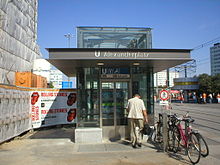
An extensive renovation program is currently being carried out on the U2 line and will be carried out over the next few years. With the opening of the section to the Pankow train station, the Senefelderplatz - Vinetastraße line was closed for several months. Nevertheless, the stations and the route of the former line A suffered a lot during the GDR era, so that the remaining stations in the former eastern part are also to be renovated. The Märkisches Museum station has been shining in new splendor since 2003 , now also with an elevator. The large Alexanderplatz transfer station also received an all-round renovation; five elevators were installed here. On the occasion of the 2006 World Cup , BVG had the Olympia-Stadion station completely renovated for 4.47 million euros . In addition to new platform slabs and the refurbishment of the entrance building, it received two elevators, which can be reached via an independent bridge from the station forecourt.
At the same time, another renovation project is also running, which includes the Alexanderplatz - city center section. Here the BVG is planning to restore the Stadtmitte, Hausvogteiplatz and Spittelmarkt train stations to their original state. The renovation of the Spittelmarkt train station has already been completed. There the window gallery has already been reopened and the back track walls have been decorated with newly fired ceramic plates and various historical city views.
Furthermore, the BVG found in 2005 that a bridge between the train stations Gleisdreieck and Bülowstraße , which dates back to the early days of the Berlin subway and was not renovated after German reunification , is showing considerable damage. The renovation of the structure, which lies directly above the mouth of the tunnel for the north-south long-distance railway , began on August 18, 2006 and was originally supposed to last until the end of the year. Due to delivery problems of the manufacturer of the new steel bridge, the Berlin public transport company extended the construction work until March 2007. During this time, the U2 line was interrupted, the eastern line section Pankow - Gleisdreieck was operated almost independently - apart from the connecting tunnel at the Alexanderplatz underground station - between Gleisdreieck and Potsdamer Platz only ran shuttle trains every ten minutes due to the complicated management. The western section of the route Ruhleben - Wittenbergplatz was extended to Warschauer Straße and formed the new U12 line. During this time the section Nollendorfplatz - Bülowstraße - Gleisdreieck was closed. The U1 line, on the other hand, was, as in earlier times, shortened to the Wittenbergplatz - Uhlandstraße section, while the U3 line was extended by two stations to Gleisdreieck during rush hour . During the renovation, which cost seven to eight million euros, the bridge was to be straightened at the same time so that the maximum speed can be increased from 40 to 50 km / h in the future. Other projects, such as the modernization of the U1 elevated railway or the Jannowitzbrücke station, were delayed due to the refurbishment, which was not included in the BVG construction budget . Regular traffic on the U2 line was resumed on March 19, 2007 after the construction work was completed.
After the fire at Deutsche Oper station , the BVG decided to retrofit all stations with only one exit with a second exit for security reasons. Since spring 2006, the stations Theodor-Heuss-Platz , Sophie-Charlotte-Platz and Deutsche Oper have had another exit at the other end of the platform.
In addition to the renovation program, the installation of elevators is also ongoing . In recent years, the Schönhauser Allee , Märkisches Museum , Alexanderplatz , Stadtmitte , Gleisdreieck, Theodor-Heuss-Platz , Olympic Stadium and, at the beginning of 2009, the Potsdamer Platz station, which is very important for tourists, have been given an elevator.
In 2009 and 2010, the 1.7 kilometer long viaduct of the elevated railway between the Pankow and Senefelderplatz stations was extensively renovated; almost 100 million euros were spent on this. In this context, the Eberswalder Strasse station was given an elevator. This means that 20 of the 29 stations currently (as of 2015) have barrier-free access. Fittings were already planned for 2010 at the Rosa-Luxemburg-Platz , Klosterstrasse , and Kaiserdamm stations , but have not yet been implemented (as of September 2012). Further planning at Ernst-Reuter-Platz is also open . The remaining five train stations will not have an elevator until after 2012 due to their minor location.
From the end of January to March 26, 2015, all the stations were announced by celebrities as part of the “Make a message - give a Berlin subway station your voice!” . The speakers included well-known personalities such as Marius Müller-Westernhagen , Otto Waalkes , Dieter Hallervorden , Frank Zander , Matthias Schweighöfer , Katja Riemann and Franziska van Almsick . The campaign cost 60,000 euros and was paid for from the BVG's marketing budget. The announcement by Dieter Hallervorden for the Mohrenstrasse station provoked criticism , as Hallervorden had already been accused of racism for his staging of the play I am not Rappaport .
Stations
| Travel time | Abbreviation | station | opening | location | crossing | |
|---|---|---|---|---|---|---|
| 0.0 | PA | Pankow | 2000 | underground |
|
|
| 1.5 | VIN | Vinetastraße (formerly Pankow [Vinetastraße], Pankow ) | 1930 | underground |
|
|
| 3.5 | Sh | Schönhauser Allee (formerly Nordring ) | 1913 | viaduct |
|
|
| 5.0 | EB | Eberswalder Strasse (formerly Danziger Strasse, Dimitroffstrasse ) | 1913 | viaduct |
|
|
| 7.0 | Sz | Senefelderplatz | 1913 | underground | ||
| 9.0 | Lu | Rosa-Luxemburg-Platz (formerly Schönhauser Tor, Horst-Wessel-Platz ) | 1913 | underground |
|
|
| 11.0 | A. | Alexanderplatz (Line A) | 1913 | underground |
|
|
| 13.0 | Ko | Klosterstrasse | 1913 | underground | ||
| 14.5 | Mk | Märkisches Museum (former Inselbrücke ) | 1913 | underground | ||
| 15.5 | Sp | Spittelmarkt | 1908 | underground | ||
| 17.0 | Hv | Hausvogteiplatz | 1908 | underground | ||
| 18.5 | Wed | City center (Line A) (formerly Friedrichstrasse, Leipziger Strasse, Friedrichstadt ) | 1908 | underground | ||
| 19.5 | MH | Mohrenstrasse (formerly Kaiserhof , Thälmannplatz, Otto-Grotewohl-Strasse ) | 1908 | underground | ||
| 21.0 | Pd | Potsdamer Platz (formerly Leipziger Platz ) | 1902/07 | underground |
|
|
| 22.5 | MB | Mendelssohn-Bartholdy-Park | 1998 | viaduct | ||
| 24.0 | Gu | Track triangle (below) | 1912 | viaduct | ||
| 26.0 | Bs | Bülowstrasse | 1902 | viaduct | ||
| 27.5 | No | Nollendorfplatz (above) | 1902 | viaduct |
|
|
| 29.5 | Wt | Wittenbergplatz | 1902 | underground |
|
|
| 31.5 | Zo | Zoological garden (above) | 1902 | underground |
|
|
| 33.5 | RP | Ernst-Reuter-Platz (formerly Knie ) | 1902 | underground | ||
| 35.5 | Obi | Deutsche Oper (formerly Bismarckstrasse, Municipal Opera, German Opera House ) | 1906 | underground | ||
| 36.5 | Bmo | Bismarckstrasse (above) | 1978 | underground | ||
| 38.0 | So | Sophie-Charlotte-Platz | 1908 | underground | ||
| 39.5 | Kd | Kaiserdamm (temporarily Adenauerdamm ) | 1908 | underground | S-Bhf Messe Nord / ICC: Ringbahn |
|
| 41.0 | Th | Theodor-Heuss-Platz (formerly Reichskanzlerplatz, Adolf-Hitler-Platz ) | 1908 | underground | ||
| 43.0 | Nd | New West End | 1922 | underground | ||
| 44.5 | Sd | Olympic Stadium (former stadium, Reichssportfeld ) | 1913 | incision | ||
| 46.5 | Rl | Quiet life | 1929 | dam |
Timetable
Since the timetable change on December 12, 2004, only every second train has run to Ruhleben during peak and off-peak times , the others already end at Theodor-Heuss-Platz . Since 1990 there has been a continuous night traffic on the route Ruhleben - Wittenbergplatz (at that time still line U1) in the weekend nights . In 2003 this was extended to the entire route of the U2. Even before that there was a ten-minute night service on the East Berlin line Vinetastraße - Mohrenstraße (then: Otto-Grotewohl-Straße ).
| line | Mon-Thu (HVZ) (7 am-9:30 am and 2:30 pm-7 pm) |
Mon-Thu (NVZ) (6 am-7am; 9:30 am-2:30pm and 7 pm-9pm) |
Fri (HVZ) (7 am to 9:30 am and 2:30 pm to 6:30 pm) |
Fri (NVZ) (6 am to 7 am; 9:30 am to 2:30 pm and 6:30 pm to 10:30 pm) |
Sat (10 a.m. - 10:30 p.m.) |
Sundays and public holidays (12.30pm - 7pm) |
Off-peak time (Mon-Fri 4: 30-6 pm Monday-Thursday from 21 pm; Fri + Sat from 22:30 pm and Sun 19 am-0: 30 PM / Sat, 5: 30-10 pm and Sun 7-12: 30 o'clock) |
Night Fri / Sat and Sat / Sun as well as on the nights before public holidays (Fri / Sat 0: 30-5: 30 a.m. and Sat / Sun 0: 30-7: 00 a.m.) |
|
|---|---|---|---|---|---|---|---|---|---|
| Pankow ↔ Theodor-Heuss-Platz |
4 min school holidays 4 1 ⁄ 2 min |
5 min |
4 min school holidays 4 1 ⁄ 2 min |
5 min | 5 min | 5 min | 10 min | 15 minutes | |
| Theodor-Heuss-Platz ↔ Ruhleben |
8 min school holidays 9 min |
10 min |
8 min school holidays 9 min |
10 min | 10 min | 10 min | 10 min | 15 minutes | |
| On the nights Friday to Saturday and Saturday to Sunday the U2 trains run every 15 minutes between Pankow and Ruhleben from 0:30 a.m. to around 4:30 a.m. During the nights from Sunday / Monday to Thursday / Friday, the N2 night bus takes over the tasks of the subway. | |||||||||
Clock compression
In the Berlin Senate's 2019–2023 local transport plan, the frequency will be compressed to 3.3 minutes during rush hour by 2023.
Route planning
|
|
|||||||||||||||||||||||||||||||||||||||||||||
|---|---|---|---|---|---|---|---|---|---|---|---|---|---|---|---|---|---|---|---|---|---|---|---|---|---|---|---|---|---|---|---|---|---|---|---|---|---|---|---|---|---|---|---|---|---|
|
|||||||||||||||||||||||||||||||||||||||||||||
|
|
|||||||||||||||||||||||||||||||||||||||||||||
|
|||||||||||||||||||||||||||||||||||||||||||||
| → See: Senate Department for Transport and Enterprises | |||||||||||||||||||||||||||||||||||||||||||||
Extensions to the line were planned again and again. Since the opening of the Berlin subway, it was planned to build a line to Spandau . In 1984 this already happened with the U7, but there are still plans to extend the U2 at least to Spandau. At the Rathaus Spandau train station , where the U7 already ends today, two track troughs have already been built in order to accommodate the small-profile subway that will later arrive here without major modifications. The special thing about it would be that the U2 trains would drive on the left . However, this route is not supposed to end there, but rather five stations further north to the Falkenhagener Feld . However, according to the Senate, the latter extension is not expected until 2030.
In contrast, the extension of the U2 in the Pankow district has the greatest potential after the extension of the U5 to the main station . One station further, the U2 should go to the center of the Pankow district . These plans are not new either; this was planned since the opening of the Vinetastraße train station. However, the names of the future terminus changed frequently. Since this extension was not included in the Germania plans during the National Socialist era , there have only been concrete plans for it since GDR times. At that time it was to be called Johannes-R.-Becher-Straße , after the political change it was to be called Breite Straße again . But would also be possible Alt-Pankow , Pankow church or Pankow, Breite Straße . In the mean financial scenario 2030 of the Berlin Senate, this extension of the subway network is planned as the only small profile extension.
Opening dates
- February 18, 1902: Potsdamer Platz - Gleisdreieck
- March 11, 1902: Gleisdreieck - Zoological Garden
- December 14, 1902: Zoological Garden - Knie (today: Ernst-Reuter-Platz)
- May 14, 1906: Knie (today: Ernst-Reuter-Platz) - Bismarckstrasse (today: Deutsche Oper)
- September 28, 1907: Potsdamer Platz - Leipziger Platz
- March 29, 1908: Bismarckstrasse (today: Deutsche Oper) - Reichskanzlerplatz (today: Theodor-Heuss-Platz)
- October 1, 1908: Leipziger Platz - Spittelmarkt
- November 3, 1912: Gleisdreieck underground station
- June 8, 1913: Reichskanzlerplatz (today: Theodor-Heuss-Platz) - Stadium (today: Olympic Stadium)
- July 1, 1913: Spittelmarkt - Alexanderplatz
- July 27, 1913: Alexanderplatz - Nordring (today: Schönhauser Allee)
- December 22, 1929: Stadium (today: Olympic Stadium) - Ruhleben
- June 29, 1930: Nordring (today: Schönhauser Allee) - Pankow (today: Vinetastraße)
- April 28, 1978: Bismarckstrasse underground station
- October 1, 1998: Mendelssohn-Bartholdy-Park underground station
- September 16, 2000: Vinetastraße - Pankow
Others
The Berlin music project Patrouille dedicated its own title to the U2, Ruhleben , which portrays the stations along the Pankow - Ruhleben route with more or less funny incidents that are appropriate to the respective city area.
literature
- Paul Wittig : For the opening of the subway to Westend. Berlin, March 16, 1908.
- Paul Wittig : Lecture about the subway from Potsdamer Platz to Spittelmarkt. Reprint from the Glasers Annalen , Berlin 1908.
- Hochbahngesellschaft Berlin (Ed.): The elevated and underground railway from Spittelmarkt via Alexanderplatz to Schönhauser Allee (Nordring). Festschrift for the opening of the route, Berlin 1913.
- BVG , Nordsüdbahn AG (publisher): On the opening of the railway extension from Nordring to Pankow (Vinetastraße). Festschrift, Berlin 1930.
- Senate Department for Building and Housing (Ed.): Line U2 - restoration of a subway connection . Berlin Builds , Volume 13. Berlin, 1993.
- Alexander Seefeldt: 100 years of the magistrate's umbrella / For the company anniversary of the Spittelmarkt – Schönhauser Allee section of the Berlin subway . In: Verkehrsgeschichtliche Blätter , Volume 40, Issue 3 (May / June 2013), pp. 62–73.
- Monument Preservation Association for Local Transport Berlin: U2 - stories from the underground . GVE, Berlin 1995, ISBN 3-89218-032-6 .
Web links
- Berliner Verkehrsbetriebe - operator of the Berlin subway
- Page to the stations of the U2 in the "Berliner U-Bahn-Galerie"
- Historical writings on routes of today's U2 in the "Berlin U-Bahn Archive"
Individual evidence
- ^ Johannes Bousset: Die Berliner U-Bahn , Verlag von Wilhelm Ernst & Sohn, Berlin 1935, p. 4
- ↑ Line network of the Berlin U-Bahn 1957 ( Memento from March 4, 2006 in the Internet Archive )
- ↑ City traffic news . In: Stadtverkehr 5–6 / 1991, p. 50.
- ↑ Berliner Verkehrsseiten, Jurziczek M .: The SelTrac test operation . Berlin, 2010. Retrieved December 2, 2011 .
- ^ Monument Preservation Association Berlin Local Transport: U2 - History (s) from the underground . GVE, Berlin 1995, ISBN 3-89218-032-6 , pp. 38-40
- ↑ a b Peter Neumann: On Saturday it is the Pankower's turn . In: Berliner Zeitung , September 13, 2000
- ↑ a b c Priorities in the Berlin public transport network until 2030 ( Memento from August 28, 2006 in the Internet Archive ) (PDF; 1.4 MB) Senate Department for Urban Development
- ^ Eva Dorothée Schmid: With elevators and guidance system for the blind . In: Berliner Zeitung , June 1, 2006
- ↑ Thomas Fülling: With the U2 through history. ( Memento from March 17, 2005 in the Internet Archive ) In: Berliner Morgenpost , March 14, 2005
- ^ Stefan Jacobs: New bridge at Gleisdreieck: U2 closed until New Year's Eve . In: Der Tagesspiegel , June 27, 2006
- ^ Peter Neumann: Construction work on the U2 will take until March . In: Berliner Zeitung , December 14, 2006
- ↑ Customer magazine plus_08 of the BVG ( Memento of October 11, 2006 in the Internet Archive ) (PDF; 2.6 MB)
- ↑ Press release of the Berliner Verkehrsbetriebe , March 16, 2007
- ↑ Press release of the Berliner Verkehrsbetriebe , May 11, 2006
- ↑ The subway goes back to Pankow. In: Der Tagesspiegel . December 21, 2010, accessed July 23, 2013 .
- ↑ Written request from the Green MP Michael Cramer regarding the elevator installation, list of priorities in the appendix (PDF; 166 kB) December 1, 2003, Senate Department for Urban Development
- ↑ Colorful things: Make an announcement. (PDF) In: BVG customer magazine PLUS 02/2015. Berliner Verkehrsbetriebe (BVG), public law institution, February 2015, pp. 22,23 , accessed on February 11, 2015 .
- ↑ Andreas Baum: #weilwirdichlieben we spent € 60,000 on #promiansagen # u2. February 20, 2015, accessed February 21, 2015 .
- ↑ Christian Tretbar: Celebrity announcements in the U2 cost BVG 60,000 euros. In: Der Tagesspiegel . February 20, 2015, accessed February 21, 2015 .
- ↑ Pascale Müller : Celebrity announcements in the U2: Dieter Hallervorden is in trouble because of "Mohrenstrasse". In: Der Tagesspiegel . January 22, 2015, accessed February 21, 2015 .
- ^ Matthias Heine: Racism? Avoid Mohrenstrasse, Dieter Hallervorden! In: Welt Online . January 23, 2015, accessed February 21, 2015 .
- ↑ Controversial production: Hallervorden rejects allegations of racism. In: Spiegel Online . January 10, 2012, accessed February 21, 2015 .
- ↑ Thomas Loy: This is how BVG and S-Bahn should run in the future . The daily mirror . February 26, 2019 .: "Additional lines are to be given a ten-minute cycle, on underground lines 2,5,6 and 8 a 3.3 minute cycle is to be introduced by 2023."
- ↑ Appendix 8 to the Berlin public transport plan 2019-2013 "Framework timetable" . Senate Department for the Environment, Transport and Climate Protection of Berlin. February 25, 2019.
- ↑ Senate Department for Transport and Enterprises, as of 1995
- ↑ Jürgen Meyer-Kronthaler: Berlin's U-Bahnhöfe - The First Hundred Years , be.bra Verlag, Berlin 1996, ISBN 3-930863-16-2 , pp. 53 and 199
- ↑ PATROL Ruhleben. Retrieved July 19, 2016 .
